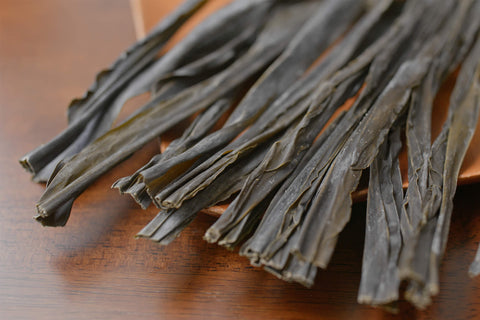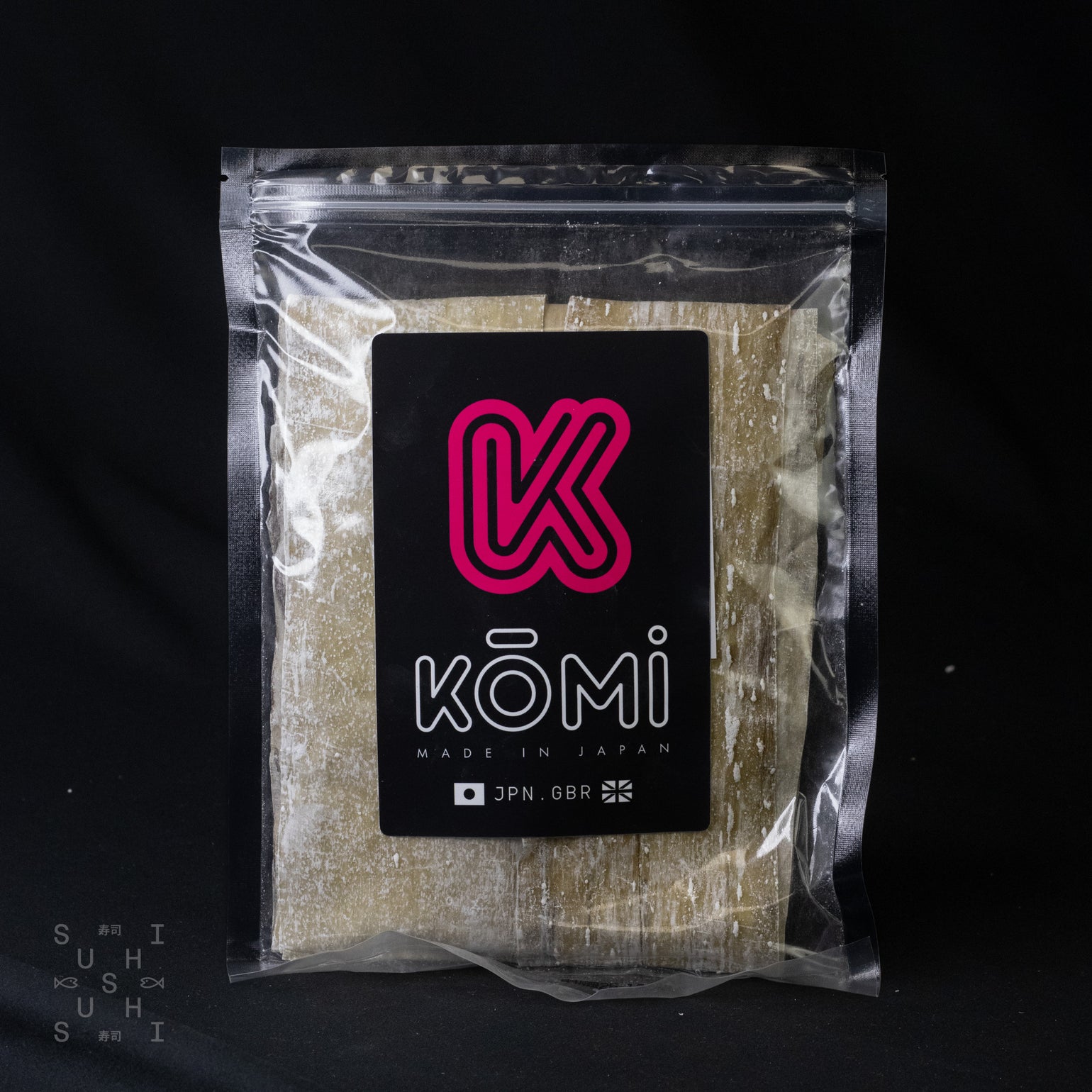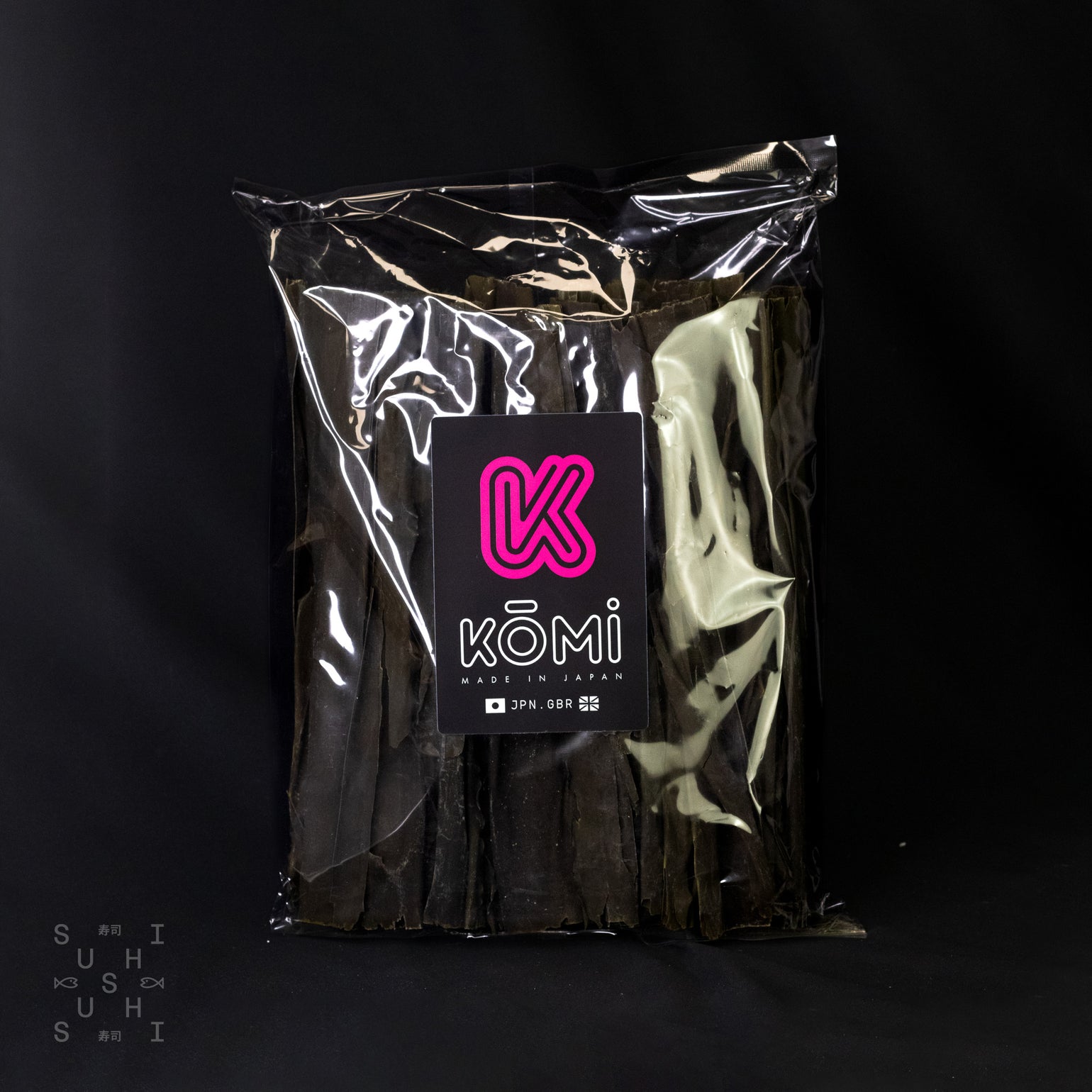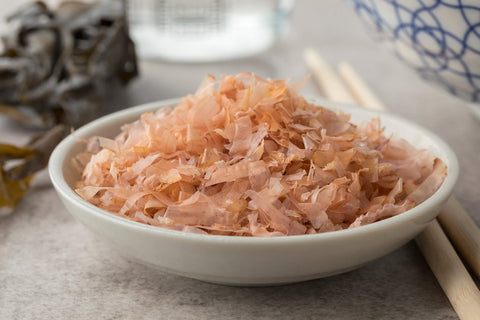
Kombu (or konbu, as it is spelled in Japan) is a form of edible kelp or seaweed, commonly used in East Asian cooking. It refers to a wide variety of kelp, most of which are from the laminariaceae family. Kombu is easy to grow, often resulting in plentiful harvests and is a major part of the Japanese diet. While other cultures around the world make use of kelp – including China and Iceland – Japan is by far the largest global consumer.
History
Kombu has been used as a foodstuff in Japan for millennia. Plant remains, including wakame seaweed, have been uncovered in ancient ruins dating back to the Jōmon Period (14000-300 BCE), and scholars believe that this suggests kombu (or an earlier equivalent) was also eaten at the time. The earliest written references to the food come from wood strips from the imperial capital of Fujiwara-kyō (694-710) and the Man'yōshū – the earliest existing collection of Japanese poetry, collected in 759. At this time, kombu would have been harvested and dried by hand, or used fresh in soups and broths.
New drying techniques were developed during the Muromachi period of 1336 to 1573, which allowed kombu to be stored over a longer period of time. By the Edo period (1603-1867), kombu was a widely-used ingredient throughout the country. At this time, kelp farmers were still harvesting wild kelp. It was not until the early 20th century that the crop was cultivated. This resulted in cheaper and more plentiful kombu.
Main Varieties
Most kombu comes from the laminariaceae family of kelp, of which there are about eighteen different varieties. Each has its own distinct flavour and some are only cultivated in certain coastal areas around the country. The most popular and readily-available varieties are as follows:
Formal Name
Japanese Name
Of particular note, rishiri-kombu is commonly used for making soup stocks, while mitsuishi-kombu is often used in the production of dashi. Karafuto-kombu contains a naturally-occurring sugar, known as mannitol, producing a sweeter flavour than other varieties.
Production
While kombu does grow in the wild and can be harvested by hand, to do so on an industrial scale requires more efficient farming methods and some form of mechanisation. Cultivated kombu begins in the nursery, where spores are germinated and seeded into ropes that are then tied to a frame. The spores are able to sprout on these ropes, at which point they are transferred to thicker ropes that are hung in the ocean.
Cultivated kombu is ready to be harvested within a year, and many farms rotate their kelp fields to ensure a steady, year-round supply.
Harvesting the kombu is a simple matter of hauling in the ropes. The ‘leaves’ of kelp are stripped from the ropes, either by hand or with a dedicated machine. In either instance, the roots remain and can regrow back in the ocean. The raw kelp is then shipped for processing.
This involves sheets of kelp being soaked in a vinegar solution as a form of preservative. Following this, they are dried and stacked, before being compressed to release any remaining moisture. These blocks of compressed kombu are then set aside to age. Once they are ready, they are shaved into individual sheets that, when combined with boiling water, at both flavour and texture to a range of dishes.
Kombu in Japanese Cooking
Kombu is a popular ingredient in Japanese cuisine, being high in glutamic acid, which creates the savoury, umami flavour that is a hallmark of the country’s food.
It is sold in several ways, including dashi kombu (dried), su kombu (pickled in vinegar), or dried and shredded as shiraga kombu, oboro kombu, or tororo kombu. Fresh kombu can also be purchased and is often eaten with sashimi. Kombu is also available in both powdered and liquid stock forms.
As previously mentioned, kombu is used on its own to flavour and thicken soup, or as a core ingredient for making the popular soup stock dashi. Kombu that has been softened during cooking is eaten as part of the meal, or sliced and simmered in mirin and soy sauce to make tsukudani.
Kombu can also be pickled, often with a sweet and sour flavour. In this form, it is often eaten as a snack alongside a cup of green tea.
Speaking of tea, kombu-cha is a popular and healthy tea made by infusing dried and shredded kombu in hot water.
Kombu in Modern Western Cooking
Kombu is being used in a variety of ways in modern western cooking especially in fine dining. Stock or "dashi" is made from the kombu and this stock is blended with classic western stocks to reinforce umami flavours.
Another technique that is being employed is "kombujime". Kombujime is a technique where fish is wrapped for 1 to 5 days in kombu to extract bad flavours of fish, whilst imparting umami sea flavours to enhance the fish.
Nutritional Benefits
As well as being a good source of glutamic acid, kombu also contains high levels of iodine, essential for healthy growth and development. Kombu is also a great source of dietary fibre and contains several enzymes (including alpha-galactosidase and beta-galactosidase) that can break down complex sugars in the stomach that are usually indigestible.
Popular Products
These are just some of the kombu products and variations that prove particularly popular at SushiSushi. Click on a link to learn more, or visit our online store for more kombu products.
Komi White Kombu (Shiraita)
Delicately crafted through a meticulous process, this ultra-thin white kombu is first marinated in vinegar before being expertly sliced to paper-thin perfection without tearing. Made exclusively by skilled artisans, it’s a favourite in high-end sushi preparation, particularly for wrapping mackerel (saba) sushi, where its subtle umami and refined texture elevate both flavour and presentation.
Tomoe Hokkaido Konbu
Kombu dashi is suitable for vegetarians, as it is produced without using any bonito fish, relying on the kombu for its flavour. This particularly kombu dashi concentrate uses seaweed farmed off the coasts of Hokkaido – a region famed for the quality of its kelp, seaweed, and other marine vegetation.
Komi Ma Kombu
Sourced from the pristine waters off Hokkaido, this premium-grade Ma Kombu is prized for its broad, thick fronds and deep, natural umami. A staple of authentic Japanese cooking, it’s ideal for creating rich, flavourful dashi stock - perfect for soups, broths, and sauces. Its subtle sweetness and savoury depth also enhance rice, noodle dishes, and a wide range of savoury recipes.
Our Suppliers
Here at SushiSushi, we source our kombu from some of the most well-respected and established producers in Japan. These include:
Tokon
Originally Formed in 1933 and relaunched in 2002, Tokon is renowned throughout Japan and across the world for the quality of its kombu and dashi products. They are committed to the principle of delivering health and satisfaction to all their customers.
Naya Shoten
Established over 110 years ago, Nayan Shoten Co Ltd harvests its kombu direct from the Hokkaido region of Japan. For more than a century, they have devoted themselves to creating quality kombu products, carefully processing the kelp to release its natural umami flavouring.
